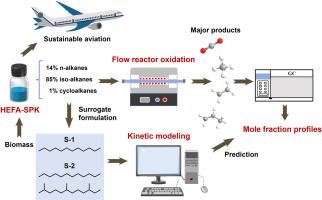Investigating the oxidation characteristic of a hydro-processed bio-jet fuel: Experimental and modeling study
IF 6.2
2区 工程技术
Q2 ENERGY & FUELS
引用次数: 0
Abstract
A rapid transition from conventional jet fuels to sustainable aviation fuels (SAFs) is imperative in order to reduce carbon emissions. Hydro-processed esters and fatty acids synthetic paraffinic kerosene (HEFA-SPK), as a type of SAF, exhibits broad applications. In this study, a new HEFA-SPK named ZH-HEFA was investigated. The fuel comprises 14% n-alkanes, 85% iso-alkanes and only 1% cycloalkanes by weight, with the majority of alkanes ranging from C9 to C17. Oxidation experiments of the fuel were conducted using an atmospheric pressure flow reactor at temperatures ranging from 550 K to 1075 K under three equivalence ratios (0.5, 1.0 and 1.5). Species mole fraction profiles were measured by an on-line gas chromatographic (GC). For comparison purposes, an experiment was also performed on RP-3, a conventional jet fuel commonly used in China, under the equivalence of 0.5. Compared to RP-3, ZH-HEFA exhibited significantly stronger low temperature reactivity and higher combustion conversion rates while demonstrating considerably lower yields of aromatics at high temperatures. The kinetic simulation of ZH-HEFA was achieved by proposing two surrogates and their corresponding kinetic models. Surrogate S-1 consisted solely of n-dodecane, while S-2 comprised 35% n-dodecane and 65% 2,6,10-trimethyl dodecane by weight. Both surrogate models were validated by the experimental data. S-1 exhibited a closer resemblance to the global oxidation characteristics of ZH-HEFA, whereas S-2 demonstrated improved accuracy in predicting the formation of small hydrocarbon intermediates during the fuel oxidation. Rate of production analysis revealed that the branched alkane component in S-2 possessed more pathways and greater capability than S-1 in generating C3 intermediates, which are important for the generation of aromatics. Furthermore, both models displayed good predictive performance for the auto-ignition properties of HEFA-SPK fuels.-

研究水处理生物喷气燃料的氧化特性:实验和模型研究
为了减少碳排放,从传统喷气燃料快速过渡到可持续航空燃料(SAF)势在必行。加氢处理酯和脂肪酸合成石蜡煤油(HEFA-SPK)作为一种 SAF,具有广泛的应用前景。本研究对一种名为 ZH-HEFA 的新型 HEFA-SPK 进行了研究。按重量计,这种燃料由 14% 的正烷烃、85% 的异构烷烃和仅 1% 的环烷烃组成,其中大部分烷烃的范围在 C9 到 C17 之间。燃料的氧化实验是在常压流动反应器中进行的,温度范围从 550 K 到 1075 K,有三种当量比(0.5、1.0 和 1.5)。通过在线气相色谱仪(GC)测量了物质的分子分数曲线。为了进行比较,还对中国常用的传统航空燃料 RP-3 进行了等效比为 0.5 的实验。与 RP-3 相比,ZH-HEFA 表现出更强的低温反应性和更高的燃烧转化率,而在高温下芳烃的产率却大大降低。ZH-HEFA 的动力学模拟是通过提出两种替代物及其相应的动力学模型来实现的。代用品 S-1 完全由正十二烷组成,而 S-2 则由 35% 的正十二烷和 65% 的 2,6,10- 三甲基十二烷组成。实验数据验证了这两种代用模型。S-1 与 ZH-HEFA 的整体氧化特性更为相似,而 S-2 则在预测燃料氧化过程中形成的小碳氢化合物中间产物方面表现出更高的准确性。生成速率分析表明,S-2 中的支链烷烃成分在生成 C3 中间体方面比 S-1 拥有更多的途径和更强的能力,而 C3 中间体对于芳烃的生成非常重要。此外,这两种模型对 HEFA-SPK 燃料的自燃特性都显示出良好的预测性能。
本文章由计算机程序翻译,如有差异,请以英文原文为准。
求助全文
约1分钟内获得全文
求助全文
来源期刊

Combustion and Flame
工程技术-工程:化工
CiteScore
9.50
自引率
20.50%
发文量
631
审稿时长
3.8 months
期刊介绍:
The mission of the journal is to publish high quality work from experimental, theoretical, and computational investigations on the fundamentals of combustion phenomena and closely allied matters. While submissions in all pertinent areas are welcomed, past and recent focus of the journal has been on:
Development and validation of reaction kinetics, reduction of reaction mechanisms and modeling of combustion systems, including:
Conventional, alternative and surrogate fuels;
Pollutants;
Particulate and aerosol formation and abatement;
Heterogeneous processes.
Experimental, theoretical, and computational studies of laminar and turbulent combustion phenomena, including:
Premixed and non-premixed flames;
Ignition and extinction phenomena;
Flame propagation;
Flame structure;
Instabilities and swirl;
Flame spread;
Multi-phase reactants.
Advances in diagnostic and computational methods in combustion, including:
Measurement and simulation of scalar and vector properties;
Novel techniques;
State-of-the art applications.
Fundamental investigations of combustion technologies and systems, including:
Internal combustion engines;
Gas turbines;
Small- and large-scale stationary combustion and power generation;
Catalytic combustion;
Combustion synthesis;
Combustion under extreme conditions;
New concepts.
 求助内容:
求助内容: 应助结果提醒方式:
应助结果提醒方式:


